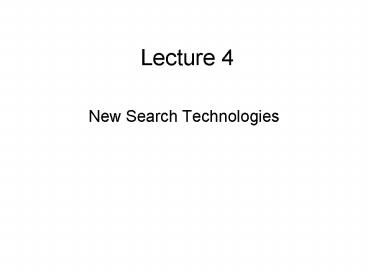New Search Technologies PowerPoint PPT Presentation
1 / 19
Title: New Search Technologies
1
Lecture 4
- New Search Technologies
2
A new search paradigm emerged
- Cannot afford to get hung up finding every tree
on huge islands - Do not allow tree buffers to fill up
- Hold only few trees at each length in each
replicate - Pool results and pass later to TBR
3
A more powerful approach Parsimony Ratchet
- Kevin Nixon (1999) - Parsimony Ratchet
- Method for more thorough exploration of tree
space than RASTBR - Branch-swapping in suboptimal areas may lead to
more optimal solutions
4
A more powerful approach Parsimony Ratchet
- Generate starting tree
- Branch-swap until an optimum is reached
- Save trees
- Reweight some 5-25 of characters chosen at
random - (Can be either up or down weighted)
- Branch-swap until new optimum reached
- Reweight characters back to original weights
- Branch-swap again
- Continue for 50-200 cycles
5
Parsimony Ratchet
- Uses perturbations to explore tree space
- Move through suboptimal areas
6
Goloboff (1999)
- RAS TBR will probably never succeed with large
data sets - Parsimony ratchet is better
- But, entirely new approaches are needed for data
sets of 150 or more taxa
7
Goloboff (1999)
- Best initial strategy is to conduct aggressive
initial searches - Drill down to shortest solutions quickly
- Dont worry about number of equally parsimonious
solutions - These can always be calculated later
- In fact, entirely unnecessary to find all equally
parsimonious trees on every island - Consensus will be the same if most islands in
tree space are sampled even with 1 or 2 trees each
8
Goloboff (1999)
- Imagine tree with 500 taxa
- Taxa arrayed in 10 sectors of 50 each
- Each sector has its own local optimum
- Local optima more or less independent of one
another - Global optimum - all sectors must be optimal
simultaneously! - Search strategy must implicitly deal with
composite optima
9
Tree Fusing (Goloboff 1999)
- Exchange sectors between multiple trees
containing identical sets of taxa - Each sector optimal on at least one tree
- Recombine sectors to find shorter global solutions
10
Sectorial Searches
- Break up large problem into sectors
- Analyze each separately
- 3 ways to determine sectors
11
1- Random Sectorial Searches
- Random Sectorial Searches (RSS)
- Analyze on particular sectors at random
- Can set size of sectors in advance
- Conduct branch-swapping on sector
- If shorter one found, insert back in tree
- Follow local, sectorial searches with global
search (TBR) to insure global optimality
12
2- Consensus Sectorial Searches
- Focus on problem areas
- Areas of poor resolution (polytomies)
- Typically smaller than random sectors
13
3- Exclusive Sectorial Search (XSS)
- Divide tree into specific number of
non-overlapping (exclusive) regions - Entire tree is analyzed
14
Tree-Drifting
- Resembles Parsimony Ratchet
- Different way of moving around in tree space
- Accept suboptimal solutions, but not too
suboptimal! - Relative fit difference between trees A and B
- RFDAB (F - C)/F
- F sum characters that differ between A and B
that fit tree A better - C sum of characters that differ between A and B
that fit tree B better - Better than raw length difference because it
accounts for actual conflicts between characters
15
Tree Drifting
- Reject suboptimal solution if
- RFD gt Z
- Z X / (F J - C)
- X is random number between 0 and 99
- J is length difference
- F and C are calculated for tree being swapped on
and candidate tree - Drift through tree space accepting trees with
probability based on relative fit difference of
characters on tree in memory and candidate tree - Stochastic component to acceptance criterion
16
TNT ProgramPablo Goloboff, Kevin Nixon, Steve
Farris
- Three search modes
- Implicit Enumeration (exact searches)
- Traditional Search Methods
- random addition sequences
- TBR or SPR branch-swapping
- New Technology Searches
- Sectorial searches
- New implementation of parsimony ratchet
- Tree-drifting
- Tree fusion
17
TNT - New Technology Searching
- Can pass trees from one algorithm to another
- Alternate cycles of TBR branch-swapping,
sectorial searches, parsimony ratchet and
tree-drifting - Typically finish with tree-fusing
18
TNT - Driver Program
- Overall control program for conducting searches
- Sort of a parsimony Expert System
- Can structure searches in various ways depending
on stage of analysis - Quickly bore down to find shorter trees
- Once most parsimonious scores are repeating,
shift to examination of structure of consensus
tree - Other advanced features
19
References
- Goloboff, P.A. (1999). Analyzing large data sets
in reasonable times solutions for composite
optima. Cladistics 15 415-428. - Nixon, K.C. (1999). The parsimony ratchet a
new method for rapid parsimony analysis.
Cladistics 407-414.

